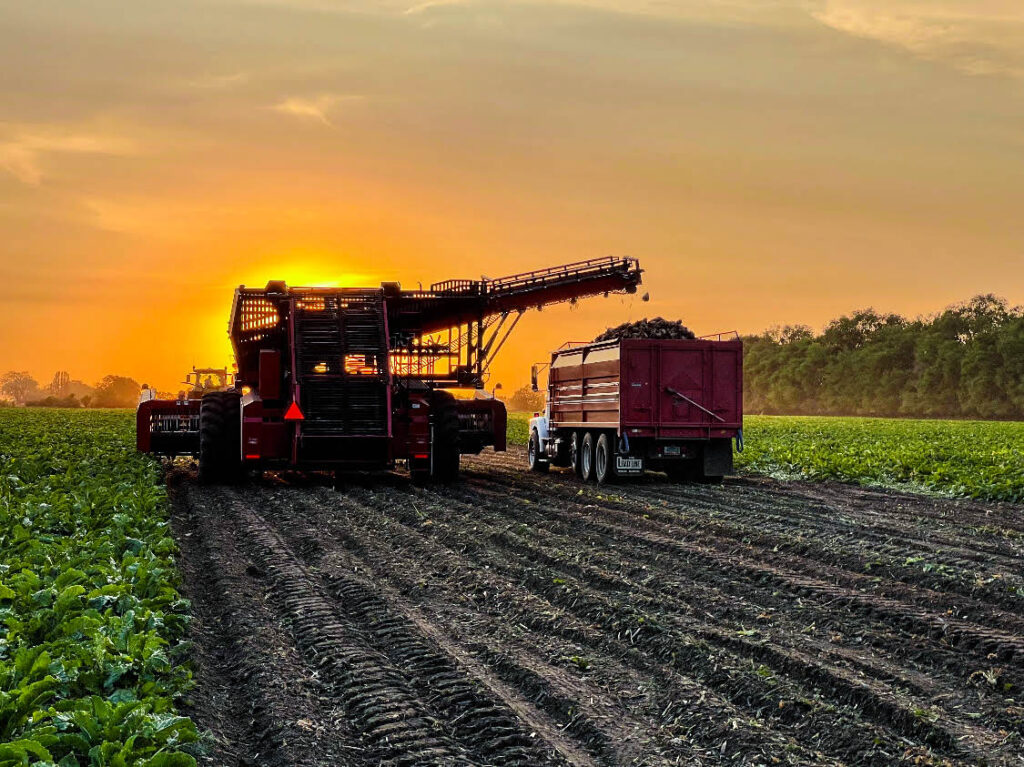
Pre-harvest in the Red River Valley. (Photo/Dustin Finney) (ABOVE) Erik Swee will again operate the beet piler at American Crystal’s Sabin piling station this month. This marks his 22nd year working in the annual beet campaign. (Photo/Nancy Hanson.)
Nancy Edmonds Hanson
Two years ago, it was copious rain and mud. This year it’s the heat. But the beet goes on – the sugar beet, that is, the bulbous cash crop that engages thousands of workers each autumn in American Crystal’s annual harvest campaign.
Farmers who lift the sugar beets from the soil and truckers who carry them to the sugar factories in Moorhead, Hillsboro, Crookston, East Grand Forks and Drayton, North Dakota, and Sidney, Montana, are the highest-profile heroes of the hour. But a large cadre of seasonal workers – men and women – plays a critical role in the middle of that process – weighing, unloading and piling the precious cargo until its time for transport to the five bustling factories.
For Erik Swee of Moorhead, the round-the-clock onslaught of tumbling beets is as much a part of autumn as falling leaves and pumpkin spice. Since 1999, the retired photographer has set aside the three weeks or so that the campaign requires, operating a piler at the Sabin station from his cab high above the growing mountain of beets.
He’s one of hundreds who man (and woman) the 33 American Crystal piling sites that line both sides of the Red River from Sabin and Kindred to the Canadian border. The Sabin site operates two pilers, each with a crew of three or four workers, managed by a foreman who works with a scale operator.
Erik signed on for his first harvest in 1999. The timing was right. His photography business had slowed down, beset by filmless technology and the PowerPoint programs that eliminated his sideline of making 35mm slides for corporate presentations. Working on the piler crew presented a welcome short-term opportunity. “You work hard for three or four weeks, but at the end you get a nice pile of money,” he explains, confiding that he has earned from $4,000 to $7,000, depending on the duration of the harvest.
That hard work extends all the way from farm to factory during the brief window when the weather is just right. At its height, the beet campaign echoes the military meaning of that word – an intense, all-out battle to triumph over time and nature. Bringing in the crop requires just enough days, 10 to 14 of them, when the weather is just right – cool enough for the beets to top out at no more than 55 degrees down in the ground, but warm enough to prevent the heavy, lumpy roots from developing frost crystals.
For those urgent weeks, the campaign runs round the clock. Erik and his colleagues work 12-hour days seven days a week. Their labor is lucrative, he points out. “Eight hours a day is at the regular wage; then you get time and a half for the other four. Saturdays are time and a half, and Sundays are double time. If you get three Sundays, it really adds up.”
During his early years of running the Sabin piler, Erik says, the crews ranged wildly from experienced field workers to teens barely out of school. Today the staffing is more predictable, thanks to the RV nomads. That wandering tribe of full-time R-Vers tracks down jobs online and apply to Express Employment Professionals, which has handled hiring in recent years.
“Most of the people on our crews now are retired couples who spend the year traveling,” he says. “Lots of them have management or business experience, and well-paid short-term work like this is just what they’re looking for. They work the national parks out west for the summer, then come through here in time for sugar beets. Afterwards, they keep moving on.” Most, he adds, consider Texas or Florida their home base.
Erik describes his own role as a solitary one. Perched in the cab of a piler 20 or 30 yards above the crew, he enjoys the view and occasional idle moments of watching the folks down below: “They’re good people, but we don’t have much time to visit.”
The start of this year’s campaign has been delayed at least until this weekend. “It’s the latest I can remember,” he notes. Daily temperatures far above the norm mean that the beets still in the ground are still warmer than the 55-degree maximum required for safe storage. Beets pulled and piled under either excess heat or temperatures below freezing are likely to spoil before they can be processed.
As he heads into his 22nd season, one he predicts may be his last, Erik reflects the rewards of working the harvest campaign. “It’s completely different from my career. I get the satisfaction of doing a job that keeps the harvest rolling. By the end of the day, you can see how much the pile has grown because you’ve done your job.”


